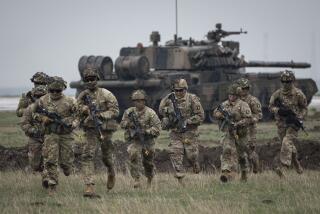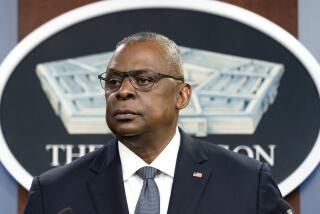Gen. McChrystal calls for overhaul of Afghanistan war strategy
WASHINGTON — A top U.S. and allied commander set the stage for a recommendation to increase the number of U.S. troops in Afghanistan, calling Monday for an overhaul in strategy to help stem losses that began during the Bush administration and have accelerated in recent months.
In a brief statement about his internal report, released by the command in Afghanistan, Army Gen. Stanley A. McChrystal acknowledged that turning the war around would be difficult.
“The situation in Afghanistan is serious, but success is achievable and demands a revised implementation strategy, commitment and resolve, and increased unity of effort,” McChrystal said.
In his report, which was prepared for military leaders, McChrystal did not specifically recommend a troop increase, instead spelling out plans to intensify development of Afghan security forces, improve the country’s government and refocus economic development initiatives, according to a description by NATO officials.
But McChrystal is widely expected among military officials to seek extra troops, and experts said Monday that his assessment would almost certainly lead to such a request in coming months.
“It is hard to imagine he is not going to ask for more troops,” said retired Maj. Gen. William Nash.
The assessment reflects McChrystal’s belief that the U.S. and North Atlantic Treaty Organization need to adopt a counterinsurgency warfare strategy that focuses on making Afghan citizens feel safer, military officials said.
Such a strategy would rely more heavily on the presence of troops, probably requiring greater numbers than the combined U.S. and NATO force, which has passed the 100,000 mark this year. McChrystal commands the combined force.
“It cannot be done without more troops. And Gen. McChrystal will ask for them,” said a former senior U.S. Defense official who spoke on condition of anonymity because of the sensitivity of the troop increase issue.
The report was issued to NATO and to Gen. David H. Petraeus, head of U.S. Central Command, which controls forces in the Mideast. The U.S. military, which considers the report a confidential internal document, does not plan to release it to the public, a Defense official said.
McChrystal’s assessment came amid a series of challenges, including two consecutive months of record U.S. military deaths in Afghanistan. On Monday, two U.S. service members and two British troops were killed in separate attacks in the south, officials said.
Defense Secretary Robert M. Gates, who originally requested the assessment, said Monday that he had not yet seen it but acknowledged “a tough fight” ahead.
White House Press Secretary Robert Gibbs declined to say whether the Obama administration would approve more troops.
Estimates of additional troop needs vary widely, ranging from a few thousand to more than 20,000. President Obama has already ordered 21,000 additional troops to bring the U.S. force to 68,000, but some White House officials have expressed concern about sending more.
“The administration doesn’t want to be receiving more of those requests, so McChrystal must feel pressure to avoid asking for too many more troops,” said Mark Moyar, a counterinsurgency expert at the Marine Corps University.
Although most contents of Monday’s assessment were not released, military officials involved in its preparation said McChrystal planned to call for an intensified effort to train more Afghan security forces, boost intelligence-gathering efforts and improve how that information is used and shared.
They said the general also would discuss plans to develop a cadre of enlisted American experts committed to the war and to improve coordination between civilian and military efforts, particularly on development projects.
McChrystal outlined some of the basics of the new strategy last week in a seven-page counterinsurgency guidance document.
“We will not win simply by killing insurgents,” he wrote. “We will help the Afghan people win by securing them, by protecting them from intimidation, violence and abuse.”
The military must “communicate -- through word and deed” that NATO and Afghan forces can protect the people, he said.
An early step in the new strategy was addressing civilian casualties. McChrystal issued a directive in early July that appears to have helped markedly reduce the number of Afghan civilians that military officials say have been killed in U.S. bombings.
Top military officials in Afghanistan argue that the current goal of 135,000 Afghan army members should be doubled.
McChrystal has said that training could be hastened by improving the partnerships between Afghan units and international combat forces.
American and NATO combat units do not always operate in the same areas as Afghan units. Military commanders said they want to position the units in closer proximity so they can regularly work together.
“We have to think our way through this problem,” McChrystal said in July. “It is not going to be solved by brute force.”
The command in Afghanistan also is overhauling the way it collects and uses intelligence.
Before McChrystal arrived, the military spread its intelligence capabilities evenly around the country.
Under McChrystal and his intelligence chief, Maj. Gen. Michael T. Flynn, the military is concentrating intelligence officers in crucial areas, following key targets for long periods of time.
The military is also creating “fusion centers” around the country to ensure military units have quick access to new intelligence. At the centers, commanders and intelligence officers work closely together to plan military operations based on the latest information.
Moyar, who wrote a book on counterinsurgency called “A Question of Command,” cautioned that pushing to expand the forces too quickly could produce inexperienced officers and poorly led troops.
“We need to be very cautious on how we expand the Afghan security forces,” Moyar said.
--
More to Read
Sign up for Essential California
The most important California stories and recommendations in your inbox every morning.
You may occasionally receive promotional content from the Los Angeles Times.










